Yes, we do. We buy all precious metals and gemstones, along with coins, fine timepieces, and sterling silver that includes jewelry, flatware, and tableware. It doesn’t really matter what the shape is or if it’s tarnished, crushed, broken or just basically ugly. We’ll buy it. As long as it is a karat gold, sterling silver or platinum. If you aren’t sure what you have, bring it in and we can help you sort through everything so that you can make an informed decision on what to sell.
So, you are ready to sell some precious metals? Great. Just put it in a bag, Tupperware, shoebox, or any other container. Make sure everything is secured and bring it into our shop. We will be more than happy to help you determine what is worth selling and what is not.
Please be safe when traveling with valuables. Don’t leave them in the car if you plan on running other errands. Make your outing to do this your first stop for safety. We care and want to make this process as easy for you as possible.


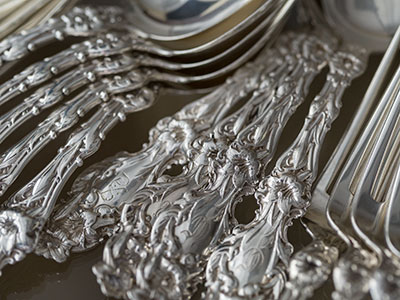
Yes, we do both. We use the highest quality materials to professionally restring your fine strand of pearls so that you may enjoy them for years to come.
Yes, and it can be fairly simple. For a quick fix just use some rubbing alcohol on a Q-tip or in a small bowl to give your diamonds a little sparkle before heading out the door.
You’re also welcome to bring your jewelry into our store. We can clean many items in a few minutes as well as offer maintenance and cleaning advice on your specific pieces.
Yes, we have a certified gemologist that can do itemized appraisals that can be submitted to your insurance carrier. You will receive a written copy of your appraisal with a detailed description of the item being appraised, a photo of the piece, the date and the retail replacement value. This appraisal will be good for at least 2-3 years, or as your insurance carrier dictates.
Most insurance companies require you to update your jewelry appraisals in a timely manner. You should check with your carrier to see how often this should be done to ensure you always have proper coverage. A copy of your appraisal is kept on file, so that when it is time to update the item, we can do so easily and conveniently. If the item has been changed or updated in any way, we simply need to re-evaluate it at our shop for a nominal fee.
"It’s a good idea to let us see your jewelry every so often to check prongs and daily wear and tear, for signs of weakness. We want to inspect it to ensure it’s in tiptop shape and ready for you to continue to wear safely."
Roz Potenza


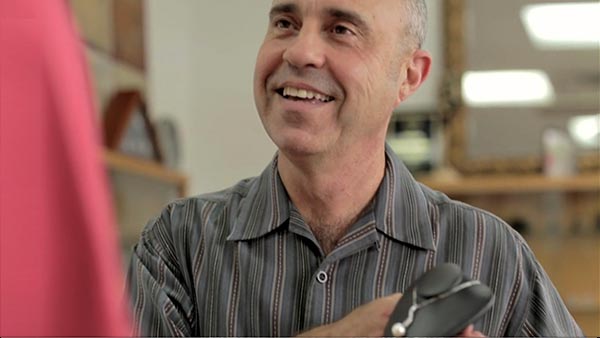
A professional appraisal for a single item is one hundred dollars and comes with paperwork that covers you should something happen to your jewelry. If you look at the cost of this appraisal compared with the thousands you have spent on your jewelry, it’s a wise investment. The gemologist will work with you for pricing on multiple items. Not everything needs an appraisal, but many things should have one. We can help you to figure out what needs it and what doesn’t.
We can also help you with the task of insuring your jewelry. We use a company called Jewelers Mutual, that we highly recommend, but you can also use any reputable carrier. Some people prefer to take a rider out with their homeowners insurance company. Like everything else, you should get a few quotes before signing on the dotted line. It’s not about saving money. It’s about having proper coverage for your jewelry if the need to replace it, arises.


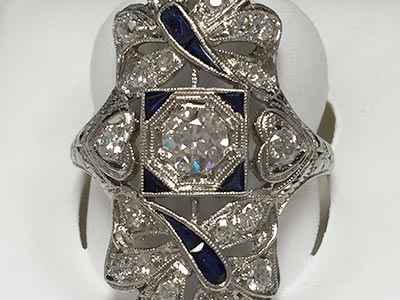
Only your insurance carrier can give you a definitive answer to that question. Design One recommends every 3 years. If you redesign a piece, you will need to have it updated on your appraisal to reflect the changes. Insurance appraisals are very important, and many people don’t get them done. We know time is a premium, so we try to make the experience as easy as we can. You can make an appointment with our independent jewelry appraiser and meet her in the convenience of our shop, or you can drop your jewelry off and we can take care of the details of getting it appraised.
Design One always recommends that you use a third non-interested party when having your precious items appraised. What does that mean? It means that this person does not buy or sell jewelry. This person’s sole job is to appraise jewelry and has proper accreditations to do so. Our appraisers all have a G.G. which stands for a Graduate Gemologist. They don’t achieve this without a lot of study and hard work. Our appraisers are graduates of GIA (the Gemological Institute of America), which is the best and most recognized organization in this field.
Unfortunately, there is no one simple answer, because it depends on many factors, namely market value and personal value. However, we can help you determine the best answer for your jewelry.
We highly recommend that you insure fine, high-end jewelry items.
Only you know if something has sentimental value; if something is truly irreplaceable to you (e.g. a family heirloom), then you should consider insuring it.
However, not all jewelry needs to be insured. If you bring your piece to us, we can help you understand and evaluate the real market value of an item. There are additional factors, such as what insurance covers, and whether it’s more cost effective to pay the deductible versus simply replacing the jewelry itself.


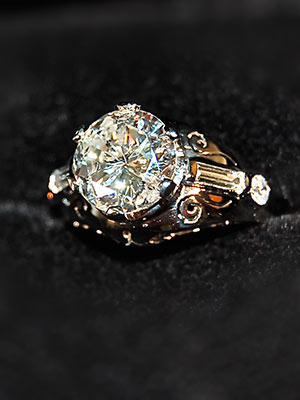
You should have your fine jewelry cleaned and inspected at least once a year (because it’s free!) Many department stores will offer a free cleaning but like everything else, I recommend going to someone you know like a trusted jewelry professional. At Design One Jewelers, if you bring it in, we can usually inspect it for any potential problems and clean it in a couple minutes. The cleaning costs nothing and the inspection can mean the difference in a lost stone and your peace of mind.
Many times we bang our rings without even realizing it. (Ever find a bruise and you have no idea how it happened?) Normal daily wear and tear can take a toll on your jewelry and a simple blow can move or crack a prong. You can’t see this sort of thing with the naked eye. Most people find out that they have a prong issue because it either starts catching on things or they lose a stone.


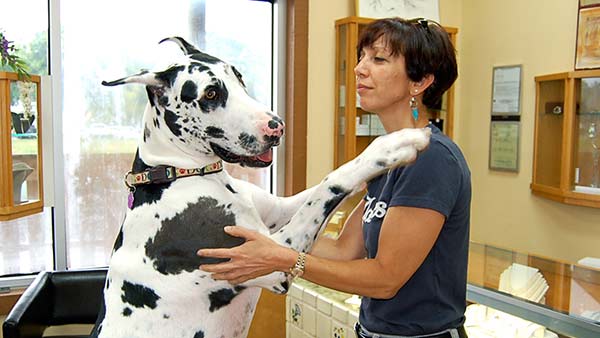


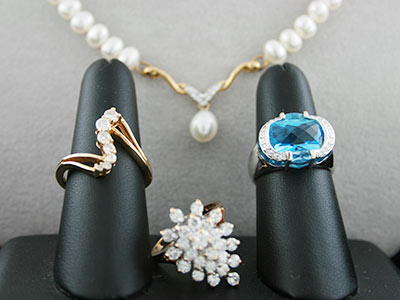
The beach may be a lot of fun for you, but not for your jewelry. Sand can scratch soft stones like tanzanites and pearls. Suntan lotion can clog up your shiny diamond. Remove your jewelry before enjoying any beachy activity. Put it in a secure location when you leave your house. Don’t drop it in the bottom of your beach bag. If you take your jewelry off while you are enjoying the rays (or if it falls off!), it can easily get lost in the sand. While it keeps those guys with their metal detectors busy, it can be a real heartbreak for you. Prolonged frolicking in the water can cause fingers to shrink, making it easier for rings to slip off. If you feel secure in wearing your jewelry, do not remove it for any reason at the beach. If it gets slimed by lotion or a giant jellyfish, leave it on and clean it once you are home. Okay, you might want to take it off if there is a giant jellyfish stuck in it.
Our professional recommendation is: Don’t clean your house or go to the gym wearing your jewelry. Roz says, “as a person who does both, we can only offer the suggestion”. We have heard many stories over the years about how someone lost a stone while gardening, they bent the shank of their engagement ring while lifting weights or the metal on their jewelry suddenly turned dark and they couldn’t figure out why.
Household chemicals can really kick your jewelry’s butt. Even pedestrian things like perfumes and lotions can make a beautiful diamond look dull and lifeless. So, what to do? If you think you should take your stuff off, you are probably right. Hard work is hard on us and our jewelry. When in doubt, take it off and store it in a secure location.
Note how I’m always going on about that secure location?


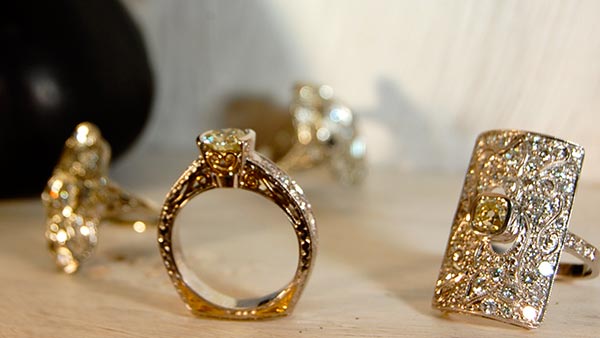
I suffer from C.R.S. (Can’t Remember S**t) these days so when I put something away I don’t always remember where. I’ve come to realize that putting things back where they belong, a sort of mise en place if you will, will keep a few of those gray hairs away. Jewelry boxes are a great way to organize your jewelry. Unfortunately, they’re also a natural target for burglars. For expensive, sentimental or very fine pieces, consider hiding them somewhere else in the house or in a fire-resistant safe.
The last thing I usually recommend is a jewelry box, as it is a one stop shopping place for the career criminal, however, (*see my CRS statement) if that’s the place that works for you – it’s better than being lost in the bottom of a sock drawer. I suggest creativity when storing your jewelry at home but less is more. When choosing a location, think like a criminal, but don’t make it so hard that you’ll never find it again either. If you have a home safe, that is the best case scenario, but few of us have one of those.
I don’t recommend keeping all your fine valuables in one place either. One home invasion can wipe you out of generations of family jewelry. Safety deposit boxes are good for long term storage of jewelry you don’t wear every day. Use good old fashioned common sense and use the same place all the time. Don’t come up with a new place every two weeks, or it’ll be as frustrating as trying to remember all those computer passwords.
When traveling, consider leaving your good jewelry at home or in a safety deposit box. If you’re staying at a hotel, ask the front desk if they can hold it in the hotel safe.
Some gemstones are delicate, so should be stored away from extremes like heat and cold. Pearls like to breathe so they shouldn’t be stored in airtight plastics. Chains love to tangle. If you put a chain down and pick it up again it will invariably have a knot or kink in it. I’ve seen things tangled together that look physically impossible, but it happens all the time. To prevent scratches and unnecessary wear to your jewelry, treat it kindly by storing it separately in soft containers, pouches, boxes or cloths.
Diamonds aren’t indestructible. They can scratch, crack and chip, so try to avoid any hard knocks. If you do give it a good whack, bring it in and get it checked. When taking your jewelry off, avoid sinks or floor vents. Don’t leave it where it can easily fall off an edge and into some nook where it can get lost forever.
Unless you are somewhere secure, like a bank or your favorite jewelry store, try to avoid taking your jewelry off in public places. Even your pockets can be risky. All you have to do is take something else out of your pocket, and your jewelry can inadvertently come out with it. One of the most popular methods is using a paper towel or tissue. Bad idea! I would love to know (statistically) how much jewelry gets thrown out accidentally on an annual basis. Tissues and paper towels get balled up and mistaken for trash all too often, so we recommend against it.


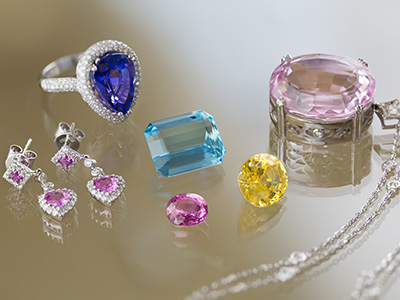



We have accumulated experience at Design One Jewelers since 1980, and we want to use that knowledge to help you with all your jewelry needs.
Do you have a question that you’d like to ask before heading out the door to the shop? Drop us a line. We will answer your questions to the best of our abilities, but feel free to look around our site too. You may just find the answer you’re looking for right here!

If you would like to send us pictures or other attachments, just let us know in your message above. When we respond to your email, you’ll have an address which you can use to send us your attachments.